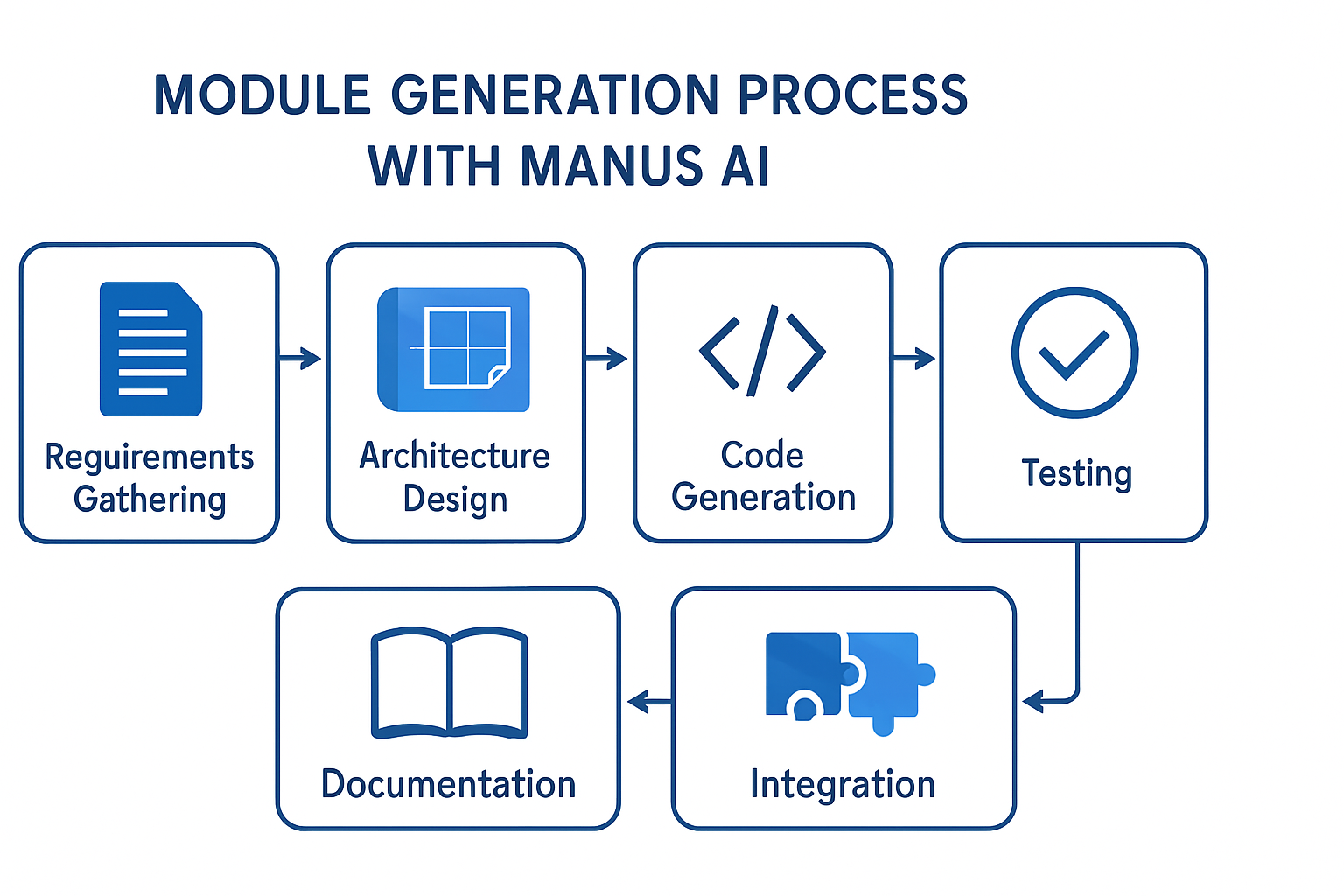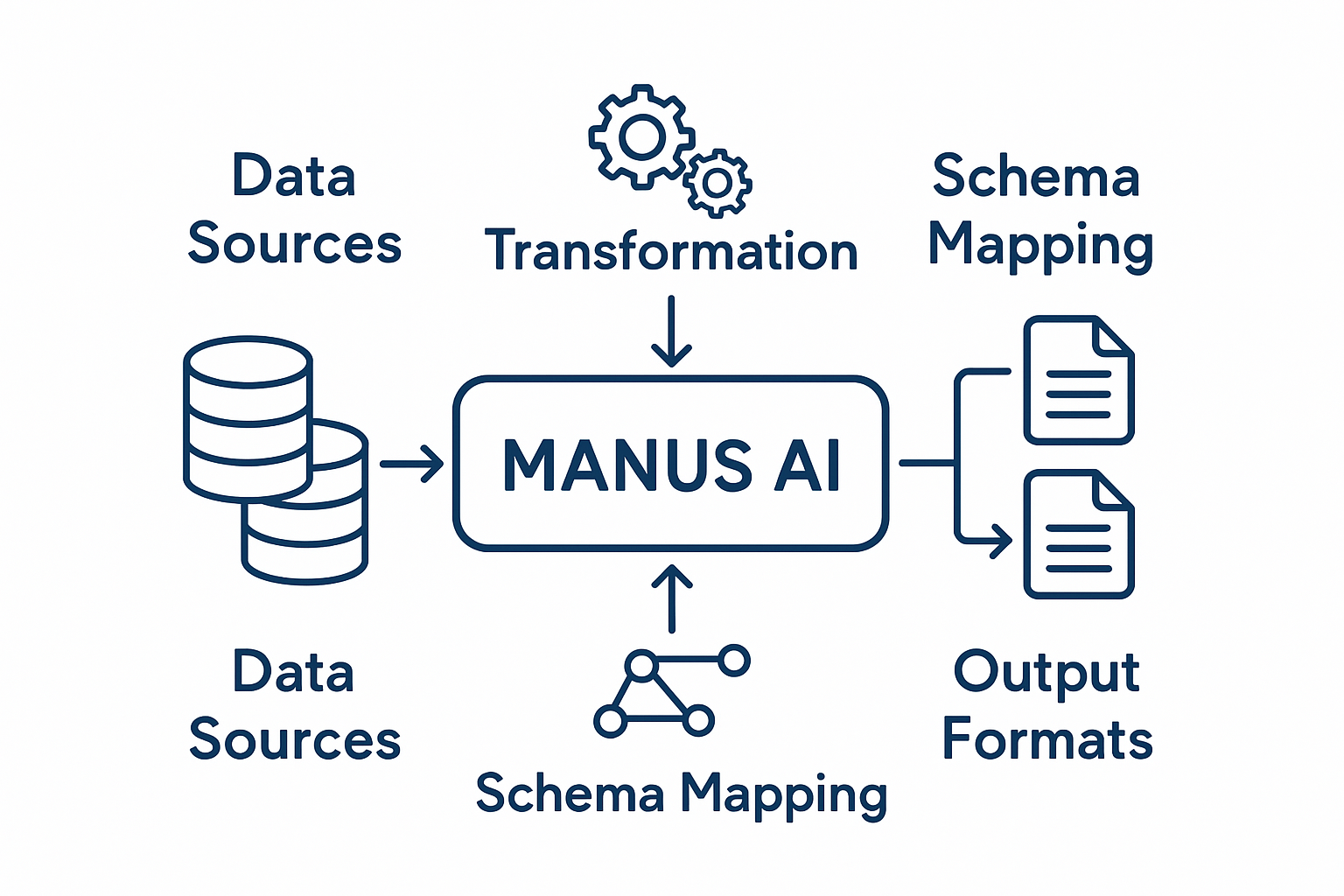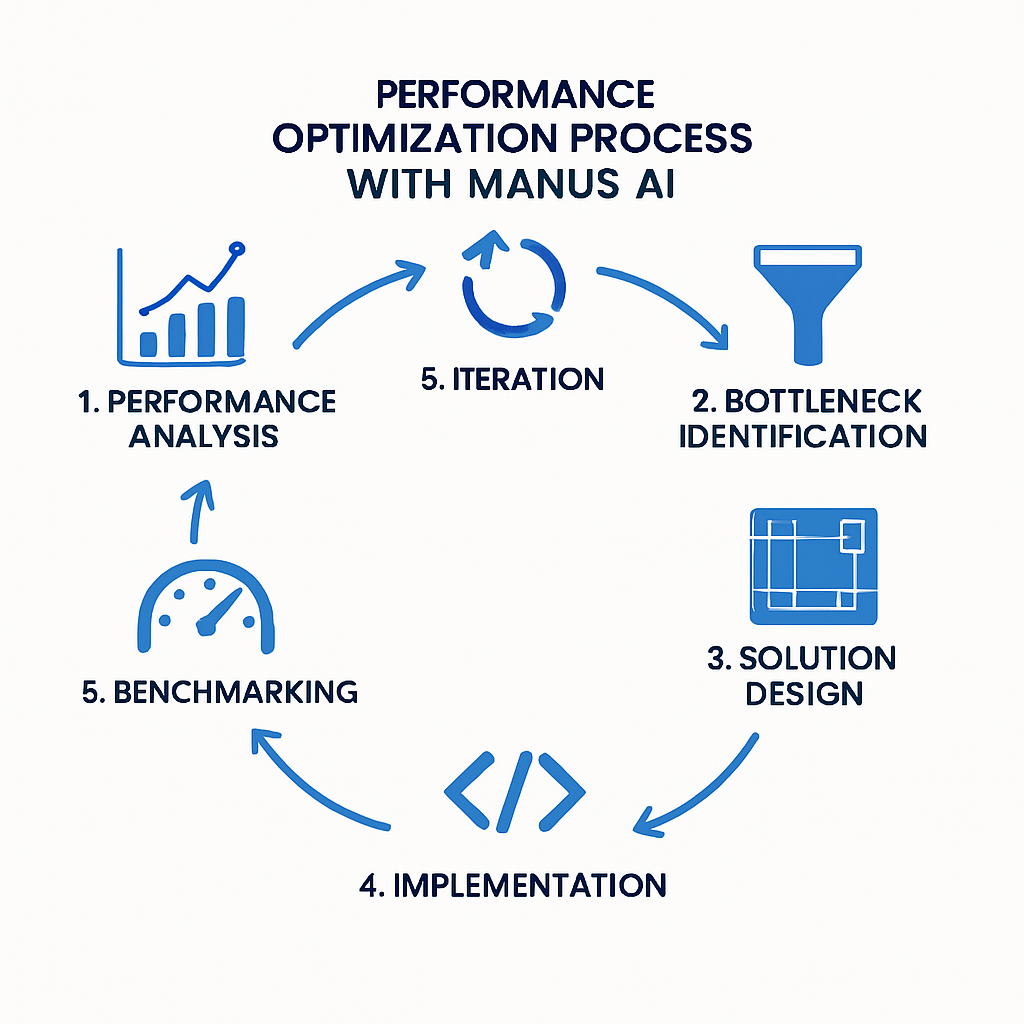Intermediate Lesson 1: Advanced Techniques
Learning Objectives
By the end of this lesson, you will be able to:
- Apply advanced techniques to optimize Manus AI performance
- Implement complex workflows using Manus AI's capabilities
- Utilize advanced prompt engineering for specialized tasks
- Integrate external tools and data sources with Manus AI
Advanced Prompt Engineering
Beyond Basic Instructions
Advanced prompt engineering involves crafting instructions that leverage Manus AI's full capabilities. This includes:
- Chain-of-Thought Prompting: Guiding Manus through a logical sequence of reasoning steps
- Role-Based Instructions: Assigning specific roles or expertise perspectives to Manus
- Constraint Optimization: Balancing multiple competing requirements
- Iterative Refinement: Using a series of prompts that build upon previous outputs

Figure 1: Advanced Module Generation Process
Chain-of-Thought Prompting
Chain-of-Thought prompting guides Manus through a logical sequence of reasoning steps:
Basic Prompt:
Analyze the impact of remote work on urban commercial real estate.Chain-of-Thought Prompt:
Analyze the impact of remote work on urban commercial real estate by:
1. First, examining pre-pandemic baseline data on office occupancy rates and commercial lease prices in major urban centers
2. Then, tracking the changes in these metrics during and after the pandemic
3. Next, analyzing how companies have adjusted their office space strategies and what percentage have adopted permanent remote or hybrid policies
4. Then, projecting how these changes will affect demand for different types of commercial spaces over the next 5 years
5. Finally, identifying potential adaptation strategies for commercial real estate owners and investors
For each step, include relevant data points and consider regional variations.Role-Based Instructions
Role-based instructions assign specific expertise perspectives to Manus:
Basic Prompt:
Create a marketing strategy for a new plant-based protein product.Role-Based Prompt:
Create a comprehensive marketing strategy for a new plant-based protein product by adopting the following expert perspectives in sequence:
1. As a market researcher: Analyze current trends in plant-based foods, identify target demographics, and outline key competitors
2. As a brand strategist: Develop positioning, messaging, and unique value propositions that differentiate from competitors
3. As a digital marketing specialist: Create a multi-channel campaign strategy with specific platforms, content types, and KPIs
4. As a retail distribution expert: Recommend optimal retail channels and in-store promotion strategies
5. As a financial analyst: Provide a budget allocation framework with expected ROI for different marketing activities
For each role, provide specific actionable recommendations based on current industry best practices.Complex Workflow Implementation
Multi-Stage Processing
Complex tasks often require multi-stage processing, where outputs from one stage become inputs for the next:
- Data Collection and Preparation: Gathering and formatting necessary information
- Analysis and Processing: Applying algorithms and transformations to the data
- Synthesis and Integration: Combining results from multiple sources or analyses
- Refinement and Optimization: Iteratively improving the results
- Presentation and Delivery: Formatting the final output for the intended audience
Example: Automated Research Workflow
Here's an example of a complex research workflow implemented with Manus AI:
Stage 1: Topic Exploration
Instruction to Manus:
"Conduct an initial exploration of recent developments in quantum computing applications for drug discovery. Identify key subtopics, major research institutions, and breakthrough papers from the last 2 years."Stage 2: Detailed Research
Instruction to Manus (using output from Stage 1):
"Based on the identified subtopics, conduct detailed research on [specific subtopic]. For each of the breakthrough papers identified, extract the methodology, key findings, and limitations. Create a comparison table of the different approaches."Stage 3: Analysis and Synthesis
Instruction to Manus (using output from Stage 2):
"Analyze the methodologies and results from the research papers to identify common patterns, contradictions, and gaps in current approaches. Synthesize this information into a coherent narrative about the current state of the field."Stage 4: Report Generation
Instruction to Manus (using output from Stage 3):
"Create a comprehensive research report on quantum computing applications in drug discovery. Include an executive summary, detailed findings organized by subtopic, visual representations of key concepts, a timeline of major developments, and recommendations for future research directions."Tool Integration and Orchestration
Extending Manus AI's Capabilities
Manus AI can be integrated with external tools and services to extend its capabilities:
- Data Processing Tools: For specialized data analysis and transformation
- Visualization Libraries: For creating advanced data visualizations
- Domain-Specific Software: For specialized tasks in fields like finance, healthcare, or engineering
- Custom APIs: For accessing proprietary data or services

Figure 2: Data Integration Architecture
Tool Orchestration Patterns
Effective tool orchestration involves:
- Tool Selection: Choosing the right tools for specific subtasks
- Data Flow Management: Ensuring smooth transfer of data between tools
- Error Handling: Detecting and recovering from failures in external tools
- Result Integration: Combining outputs from multiple tools into a coherent whole
Example: Data Analysis Pipeline
Here's an example of a data analysis pipeline that integrates multiple tools:
Step 1: Data Extraction
Instruction to Manus:
"Use the database connector to extract customer transaction data from the PostgreSQL database using the following query: [SQL query]. Format the results as a CSV file."Step 2: Data Cleaning and Transformation
Instruction to Manus:
"Using pandas, clean the extracted data by:
1. Removing duplicate entries
2. Handling missing values using appropriate imputation methods
3. Converting date strings to datetime objects
4. Normalizing currency values
Save the cleaned dataset as a new file."Step 3: Analysis and Visualization
Instruction to Manus:
"Using the cleaned dataset:
1. Calculate key metrics including average transaction value, purchase frequency, and customer lifetime value
2. Segment customers based on recency, frequency, and monetary value
3. Create visualizations using matplotlib and seaborn to illustrate:
- Monthly revenue trends
- Customer segment distribution
- Product category performance
- Geographic distribution of sales"Step 4: Report Generation
Instruction to Manus:
"Create a comprehensive business intelligence report that includes:
1. An executive summary of key findings
2. Detailed analysis with supporting visualizations
3. Customer segment profiles and recommendations
4. Appendices with methodology and data sources
Format the report as a professional PDF document."Advanced Optimization Techniques
Performance Tuning
Optimize Manus AI's performance for your specific use cases:
- Resource Allocation: Balancing computational resources across tasks
- Caching Strategies: Storing and reusing intermediate results
- Parallel Processing: Executing independent subtasks simultaneously
- Incremental Processing: Processing data in manageable chunks
Quality Optimization
Enhance the quality of Manus AI's outputs:
- Validation Rules: Defining criteria for acceptable outputs
- Iterative Refinement: Progressively improving results through feedback
- Ensemble Approaches: Combining multiple methods or models
- Human-in-the-Loop: Incorporating human feedback at critical points

Figure 3: Performance Optimization Process
Practical Exercise: Designing an Advanced Workflow
Design a multi-stage workflow for one of the following scenarios:
- A competitive analysis of the top 5 companies in an industry of your choice
- A comprehensive content strategy for a product launch
- An automated data analysis pipeline for sales performance data
- A research project on emerging technologies in a specific field
For your chosen scenario:
- Break down the task into logical stages
- Define the input and output for each stage
- Specify how outputs from one stage feed into subsequent stages
- Identify any external tools or data sources that would be integrated
- Create sample instructions for Manus AI for each stage
Knowledge Check: Advanced Techniques
Question 1
Which of the following is an example of chain-of-thought prompting?
Chain-of-thought prompting guides Manus through a logical sequence of reasoning steps. The correct answer explicitly outlines a sequence of analytical steps (identifying stakeholders, mapping interests, evaluating solutions, making recommendations) that Manus should follow in order.
Question 2
In a multi-stage processing workflow, what is the primary purpose of the synthesis and integration stage?
The synthesis and integration stage in a multi-stage processing workflow is specifically focused on combining results from multiple sources or analyses. This stage takes the outputs from previous processing steps and integrates them into a coherent whole before moving on to refinement and presentation.
Question 3
Which of the following is NOT a common tool orchestration pattern when working with Manus AI?
Autonomous Tool Creation is not a common tool orchestration pattern when working with Manus AI. The common patterns include Tool Selection (choosing the right tools for specific subtasks), Data Flow Management (ensuring smooth transfer of data between tools), Error Handling (detecting and recovering from failures), and Result Integration (combining outputs from multiple tools).
Quiz Complete!
You've completed the quiz on Advanced Techniques with Manus AI.
You've earned your progress badge for this lesson!